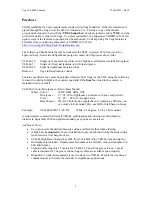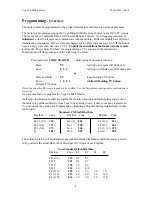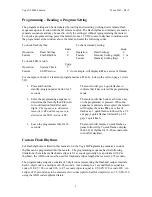
Vega VLB-44 Lantern
25 Jan 2011 - Rev 9
Programming – Reading a Program Setting
The program settings can be deciphered by reading and recording (writing down) lantern flash
sequences upon activation with the IR remote control. The flash rhythm and intensity are read as
separate sequences and may be used to verify the setting(s) without reprogramming the lantern.
To check a program setting, power the lantern from a 12 VDC source in daytime conditions, aim
the programmer at the window above the label and enter the following codes:
To check flash rhythm:
To check intensity setting:
Code
Code
Operation
Read Settings
9
Operation
Read Settings
9
Feature
Flash Rhythm
0
Feature
Intensity Setting (night) 1 or
Feature
Intensity
Setting
(day)
2
To check LED version:
Code
Operation System
Check
3
Feature
LED Version
5 (for example, will display
421
as a series of flashes)
For example, to check if a lantern is programmed as a FL4(.4), look up the code on page 3 (code
321):
1.
Press and hold the
standby/program/power button for 5
seconds.
2.
Enter the programming sequence to
determine the flash rhythm:
90
(wait
for confirmation flash after each
digit).
The sequence to determine
intensity is 91 and the sequence to
determine the LED version is 35.
3.
Leave the programmer idle for 10
seconds.
The lantern will give 4 quick flashes to
indicate that it has entered the programming
mode.
The lantern will flash once each time a key
on the programmer is pressed. When the
sequence is entered and accepted, the lantern
will display the value
321
as a series of
flashes as: 3 quick flashes followed by a 0.5
sec gap, 2 quick flashes followed by a 0.5
gap, 1 quick flash.
The lantern will display 2 quick flashes, a
pause followed by 2 quick flashes, display
the FL4(.4) rhythm for 16-20 seconds, then
turn off (if daytime).
Custom Flash Rhythms
For flash rhythms not listed in this manual or in the Vega IR Programming manual, a custom
rhythm can be programmed into the lantern. The programming sequence has the following
limitations: the minimum flash and eclipse is 0.1 seconds (generally not a problem with CG
rhythms), the ADD code must be used for flash and eclipse lengths that exceed 12.75 seconds.
The programming sequence consists of 3-digit codes representing the flash and eclipse intervals.
Each 3-digit code is a multiple of 0.05 seconds. As an example, a 1 second flash is equal to a
code of 1/0.05 = 20 or code 020. A 9.5 second eclipse is equal to 9.5/0.05=190 or code 190. An
eclipse of 15 seconds has to be entered as two codes (split in half for simplicity), so 7.5/0.05=150
using the ADD code (explained later).
9


















